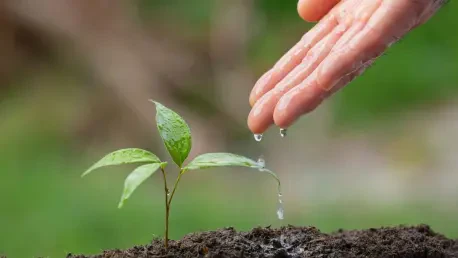What does it take to transform an arid, sun-scorched landscape into a thriving oasis of life? In Rajasthan, a state long defined by its sweeping deserts and relentless heat, a remarkable environmental movement is rewriting the story of this challenging terrain, with millions of saplings taking root across barren lands as a testament to human grit and collective vision. This extraordinary effort, planting over 102 million saplings in a single year, stands as a beacon of hope, proving that even the harshest environments can bloom with possibility.
The significance of this achievement cannot be overstated. In a region where every drop of water is precious and desertification threatens livelihoods, greening the land is more than symbolic—it’s a lifeline. This campaign, driven by both government resolve and community spirit, tackles urgent issues like soil erosion, air pollution, and climate change head-on. It’s a story of resilience, showing how a unified push can create lasting impact in the face of environmental adversity.
A Desert State’s Green Awakening
Rajasthan’s harsh climate has long posed challenges, with scarce rainfall and rising temperatures amplifying the struggle for sustainable living. Yet, amidst these difficulties, an inspiring transformation is unfolding. The state has become a canvas for one of the most ambitious tree-planting initiatives in recent memory, turning patches of dry earth into pockets of green hope.
This movement isn’t just about numbers; it’s about redefining what’s possible in a land often seen as inhospitable. By focusing on native species suited to the local conditions, the campaign ensures that each sapling has a fighting chance to survive and contribute to the ecosystem. The scale of this effort is a powerful reminder that determination can alter even the most unyielding landscapes.
The Urgency of Greening Rajasthan
Environmental challenges in Rajasthan are stark, with desertification swallowing arable land and heatwaves becoming more frequent. These issues threaten not only agriculture but also the very air that residents breathe. Increasing tree cover offers a practical solution, acting as a shield against soil degradation while improving air quality for millions.
Beyond local impact, this initiative aligns with broader global goals to combat climate change. Inspired by national efforts like the ‘Ek Ped Maa Ke Naam’ initiative, it underscores the critical role of reforestation in building resilience. For a state where every tree planted is a victory against nature’s odds, this campaign carries profound importance.
A Record-Breaking Feat in Numbers
The campaign’s success is staggering, with 102.1 million saplings planted across 2 million hectares at nearly 275,000 sites in just one year. This achievement surpassed the ambitious target of 100 million, reflecting meticulous planning and execution. Individual contributions added 3.75 million saplings, while block-level efforts accounted for an impressive 98.3 million.
Government departments played a pivotal role in this monumental task. The Education Department led with 32.5 million saplings, followed by Rural Development at 26.5 million, the Forest Department at 20 million, and the Pollution Control Board at 5 million. Geo-tagging technology ensures these young trees are monitored, enhancing their chances of survival through a data-driven approach.
The momentum continues to build, with a long-term vision of planting 500 million saplings by 2029. This year’s numbers build on last year’s success of exceeding a 70 million target by planting 75 million, highlighting a consistent upward trajectory. Such figures demonstrate not just scale but a deep-rooted commitment to sustainability.
Leadership and Community United for Change
At the heart of this green revolution is strong leadership, with Chief Minister Bhajanlal Sharma championing the cause as a legacy for future generations. “This mission is about securing a sustainable tomorrow for our children,” he declared during a recent discussion with the Minister of State for Forest and Environment, Sanjay Sharma. His words frame environmental stewardship as a shared responsibility.
Community involvement amplifies the impact, with families and local groups joining hands to plant and nurture saplings. Stories abound of schoolchildren and villagers taking pride in their contributions, turning tree-planting into a cultural movement. Symbolic acts, like unveiling campaign posters, further inspire participation across the state.
This collective spirit is underpinned by accountability, with geo-tagging ensuring transparency in tracking progress. The vision of reaching 500 million trees by 2029 is not just a goal but a promise, reflecting a blend of ambition and practical strategy. Such unity between leaders and citizens is the bedrock of this transformative effort.
Joining Hands for a Greener Tomorrow
Participation in this environmental wave is accessible to everyone, offering a chance to make a tangible difference. Local plantation drives, often announced through government channels or community networks, provide opportunities to get involved at the grassroots level. Many events are organized at block levels, making it easy to find a nearby initiative.
Choosing the right species, such as drought-resistant neem or acacia, is key to ensuring saplings thrive in Rajasthan’s tough climate. The Forest Department frequently offers free or subsidized plants, while guidance on care—like regular watering during dry months—is widely available. Individuals and groups can also use geo-tagging tools to monitor growth, adding a layer of personal investment.
Schools and organizations can partner with departments like Education or Rural Development to launch their own drives, amplifying the impact. Even planting a single tree and committing to its care contributes to the overarching goal of 500 million by 2029. Every small act builds toward a larger vision of a verdant Rajasthan.
Looking back, the campaign emerged as a powerful symbol of what collective action can achieve. It united diverse sectors and communities under a shared mission, turning barren stretches into budding landscapes. The dedication to surpassing targets and embracing technology for sustainability sets a high standard for environmental efforts.
Reflecting on this journey, the path forward becomes clear through continued engagement and innovation. Expanding public awareness, integrating more local species, and strengthening monitoring systems stand out as vital next steps. These efforts promise to deepen the impact, ensuring that the green legacy of Rajasthan endures for generations to come.









